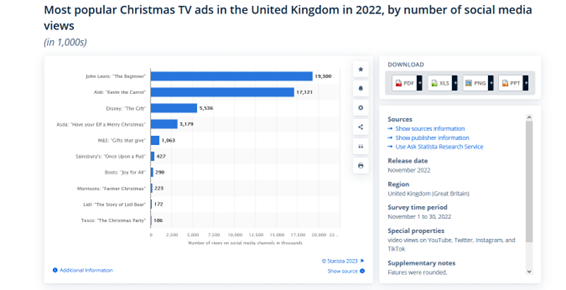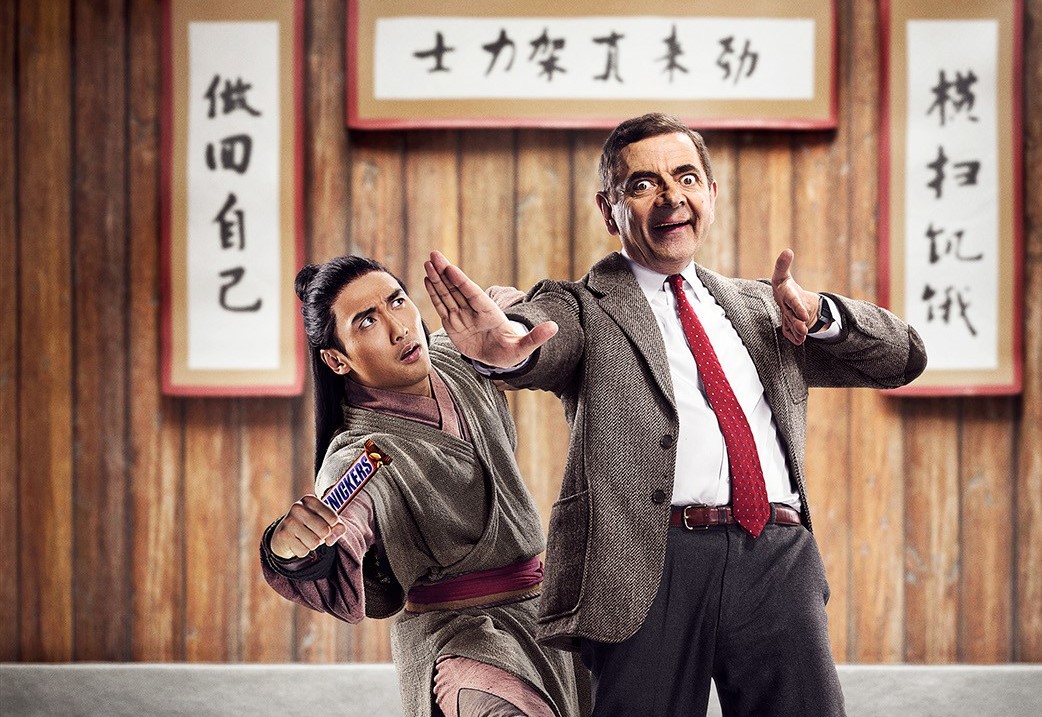If you're thinking about TV advertising in the UK, get your wallets ready. Rates for buying ad spots between TV shows start at £70 to £180 for smaller digital channels for daytime broadcasts and £160 to £330 for peak time broadcasts. A TV ad during Good Morning Britain or Lorraine will cost between £3,500 and £4,300. The production costs of filming a TV advert in Britain can range from £70,000 for a simple TV advert to £250,000 for a spectacular TV advert featuring celebrities and a famous music hit. But the result is sure to be worth it. After all, British commercials are traditionally great!
11 LIONS AND ONE GRAND PRIX FROM CANNES LIONS 2023
The great success of British ads at this year's Cannes Lions Festival of Creativity is proof that British creatives are among the top and definitely have something to offer the world. In the prestigious Film category alone, the UK took home 1 Grand Prix, 5 Gold Lions, 1 Silver Lion and 5 Bronze Lions.
Let’s look at two of the all the commercials that took home awards. Woman's Aid's campaign, He's Coming Home, which literally sends chills down the spine, targets the fight against domestic violence. The filmmakers took home the Golden Lion at the Cannes Lions. The TV spot The Last Photo on ITV X CALM (adam&eveDDB, London) even won the Grand Prix.
THE HISTORIC FIRST PLACE IN UK TV ADVERTISING GOES TO A 'WINNING' TOOTHPASTE AND A 'COLOURFUL' PEA
The very first TV commercial in the UK was a spot for Gibbs S.R. toothpaste, broadcast on 22 September 1955 at 8:12pm. The advert, produced by London-based agency Young & Rubicam, appeared on screens on the first day of the UK's first commercial TV channel, ITV. It shows toothpaste set in ice and placed in a flowing stream. The filmmakers were reportedly hampered by the melting ice and steaming of the ice block, so they used a plastic cube instead for close-ups.
What's interesting is that this ad won the chance to be aired first in a draw in which it competed against 23 other brands. And according to The Daily Telegraph, the ad itself had no particular impact on Gibbs S.R.'s sales - it made "just" £24,000.
The first British colour advert, 'Eat in full colour', was broadcast in 1969 and promoted frozen peas. The spot, created by Lintas, first aired at 10:05pm on ATV in the Midlands during the Thunderbirds programme - a time slot which the advertising firm Unilever reportedly won for just £23.
CHRISTMAS IN THE BRITISH WAY
According to statista.com, Christmas in Britain can be compared to the American Super Bowl. Christmas spots combine a high production budget and an emphasis on emotional stories. This is no surprise. After all, Brits are supposedly among the most "obsessive" when it comes to Christmas. But the legend of Christmas advertising is the John Lewis brand. For the British, the launch of the brand's Christmas advert is the unwritten kick-off to the annual Christmas advertising season. The brand has traditionally focused on xpressing the fun and magic of Christmas. It particularly succeeded in doing this in its 2014 TV spot 'Man On the Moon', which is one of the most moving in history.
British brand John Lewis has become a true legend when it comes to Christmas ads, and its commercials are among the most anticipated each year. They have been considered the gold standard for years and are eagerly awaited by many marketers besides the British, who take the ad as a benchmark for their Christmas campaigns.
But there are many more Christmas ads that have been made in Britain that are worthy of mention. Aldi's advert is undoubtedly on the list of the most successful Christmas spots. The TV spot featuring animated carrot Kevin, 'Aldi Christmas Launch Advert' (McCann, 2022), inspired by the film series Home Alone, has racked up 17 million views on social media. Since its first appearance in 2016, the anthropomorphic carrot has become a star across the UK. According to the Daily Mail, tens of thousands of customers flooded the company's website last year after the advert aired, with thousands more reportedly queuing outside stores from 4am just to get their hands on items from the new range.
The Boots brand is also worth mentioning - it came up with an interesting idea in its Christmas advert. The heroine, who has acquired new glasses, sees everyone's hidden desires after putting them on. On Christmas Eve, the glasses stop working. Why? Everyone around her is happy and satisfied - the desires have come true. In the list of the best Christmas ads of 2022, published by Time Out, this ad came first.
According to statista.com, which ranks spots based on the number of times the ads are viewed on social media, the ranking of the UK's most successful Christmas ads looks a little different, but the Boots ad is in the top ten here too.

And where else but England could an ad for a traditional British Christmas pudding be made? The Sainsbury's brand came up with the 'Once Upon a Pud' ad (agency Wieden + Kennedy London, 2022). The ad made the top 10 Christmas ads in 2022.
BRITAIN'S LONGEST TV AD
And let's stay with the UK's TOP ads for a moment. In the TV spot Dance, produced by Saatchi & Saatchi for T-Mobile, 350 dancers dance at London's Liverpool Street station. At 2 minutes and 40 seconds long, it is the longest British TV advert to date.
It seems like a lot. But it's a far cry from the Old Spice advert on Brazilian TV Woohoo. In fact, the Old Spice spot aired on 8 December 2018 and lasted a full 14 hours. By contrast, the shortest commercial lasted just one sixtieth of a second and even made it into the Guinness Book of World Records.
THE BRITS THEMSELVES ARE NOT DRY. IT’S JUST THEIR HUMOUR
According to Kantar AdReaction research, humour is increasingly the most impressive factor in advertising. The survey results show that while only 33% of ads contain elements of humour, a slight decline, a full half of the creators who won the Kantar Creative Effectiveness Awards 2023 relied on it.
As British humour is known for its specificity, often resulting from the original version of the language, it's impossible to pick just one or two ads to fit our article. You can check out some of the original British creations in their original versions here.
And it's not just British brands who appreciate dry British humour. The popularity of Britain's beloved Mr. Bean has also been used by American brand Snickers - and they couldn't have done better! Mr. Bean travels to ancient China to take part in a secret mission. However, he's not himself and can't remember his kung fu training. Until, of course, he bites into a Snickers. The commercial "You're Not You When You're Hungry" (AMV BBDO agency, London, 2014) is the first in which Rowan Atkinson has appeared since the 1990s.
TV PICK UP
And let's not forget one British specific. The so-called TV pick up refers to the moment when Brits during a commercial break are put on water for coffee or tea. Stoves and kettles all over the country are going "full blast" at that moment, sharply increasing electricity consumption. Not to mention opening the fridge door, which according to Utility Week has an even bigger impact on the electricity grid than the kettle. During high-profile TV shows, the coordinator at the UK's National Grid Control Centre doesn't know where to jump first to prevent outages on an overloaded grid. According to the BBC, one of the biggest TV pick ups occurred on July 4, 1990, as England and Germany were preparing to shoot penalties in the World Cup semi-final. The take was 2,800 MW, equivalent to 933,000 kettles on at the same time.
UK TV ADVERTISING IN FIGURES
Finally, let's summarise a few statistics that didn't fit into the article:
- Total spending on TV advertising in the UK in 2022 was £5.38 billion.
- The TV advertiser with the most views in 2022 in the UK was Procter & Gamble. Its TV ads generated 23.4 billion impressions. In second place was Sky with 19.9 billion impressions.
- The most popular TV channel in 2022 was the UK's ITV channel, with 73% of respondents giving it a positive rating. It was followed by Channel 4 and Netflix in second place and BBC One in third.
OUR NEXT STOP WILL BE....
Where will we look next on our around-the-world TV advertising journey? A country awaits where you'll probably only be able to watch an advert for the popular Haribo gummy bears in secret. That’s because, according to recent reports, the German Government is working hard on a bill to restrict junk food advertising in order to protect children. With Germany just around the corner, all you need to do is pack a few things for your trip. We're on our way!
Sources: Businessinsider.com, campaignlive.co.uk, wikipedia.org, medium.com, kantar.com, statista.com, timeout.com, monarchpartnership.co.uk, toastttv.co.uk, focus-age.cz

